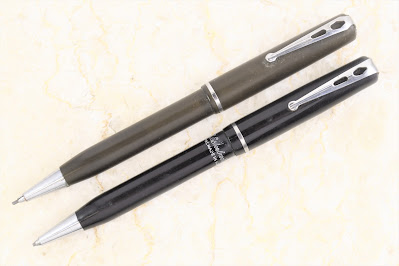This article has been included in The Leadhead's Pencil Blog Volume 7, now available here.
If you don't want the book but you enjoy the article, please consider supporting the Blog project here.
It was good to see old friends at the Raleigh Show after more than a year without any pen shows in the States. Loyal Knight R. George Adams was in attendance, and after we caught up a bit he swung by my table with some pencils that caught my interest. Here are two of them:
The plastic is called "icicle" by collectors -- I haven't seen any documentation that this was an official designation, and I'm content in the belief that it is a collector's nickname, and a good one. Here is an icicle, compared to a "normal" Esterbrook plastic:
These are the first icicle pencils I've run across, but they do turn up from time to time and command a significant premium over those in common colors. In a 2015 discussion on The Fountain Pen Network, one person joked that the rarest icicles are the black ones.
Ask any Ohio driver -- yes Virginia, if the ice is black you can still slip on it. While a "black icicle" pen might be indistinguishable from any dumb ol' Estie in black, there are subtle differences between my icicle pencils and those from the common J line. If all icicle pencils share these characteristics, one can actually identify whether a black pencil is from the icicle series. Note that the ribbing on the lower barrel is significantly shorter on my icicle pencils.
Also, note the imprint: added on the back side is an R within a circle, noting trademark registration. Esterbrook was a significant registrant of trademarks beginning in the Nineteenth century, but this designation isn't found on the regular line. I surmise this indicates the icicles were later production.
Another item to add to this Esterbrook update is the company's "transitional" model. The "transition" was from the Dollar Pencil line to the more familiar PJ series (the pens were the Model J, and "PJ" was for pencil). This example, shown between a Dollar Pencil and a PJ, is on loan from Gary Weimer:
At one end, transitional Esterbrooks share the smooth lower barrel and longer nose found on the Dollar Pencil line:
There is also one subtle difference in the top jewels: transitional models have an "outie" rather than an "innie":
Over at Esterbrook.net, Brian Anderson has noted other varieties of top jewels on transitional model pens, including one with three ribs across the center to match the clip. Transitional pencils appear to be much more difficult to find, so I don't (yet) have an opinion as to whether these varieties also exist on the pencils.
R. George also had another Esterbrook in tow at Raleigh: an Esterbrook Dollar Pencil, rendered in hard rubber rather than plastic and shown here, at top, alongside its plastic sibling:
I believe hard rubber Dollar Pencils are earlier production, and Brian Anderson dates the hard rubber pens to 1934. Note that the imprint is inconveniently higher on the barrel, where it wear off easily as the cap is depressed. That was a flaw shared with earlier Esterbrook metal pencils (see Volume 5, page 213):
Like the icicles R. George sold to me, this is the first hard rubber Dollar Pencil I've seen. Brian Anderson notes they are harder to find than the pens, but black Dollar Pencils in plastic are more scarce than their matching pens, too. I questioned David Nishimura about whether hard rubber pencils are more rare than plastic ones, and he indicated they are not significantly harder to find.
Maybe my luck has just been bad until now -- more likely is that I never took notice before one fell into my lap.












No comments:
Post a Comment